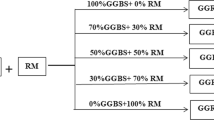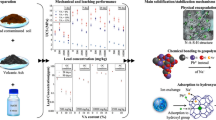Abstract
Stabilization of clayey soil has been studied by mixing different additives to the soil to increase its strength and durability. Recently, there has been an increasing interest in the stabilization of soils with natural pozzolans. Nevertheless, very few articles have investigated the impact of basic oxygen furnace (BOF) slag additives under freeze–thaw cycling. This study presents the results of an experimental research study on the durability behavior of clayey soils treated with BOF slag. In this study, the effects of clay soils on the bearing value were investigated by adding 3%, 6%, 9%, 12%, 15%, and 20% BOF slag to the clay mineral sample within the scope of ASTM D-5918 tests. California bearing ratio (CBR) tests were then applied before and after freezing–thawing processes to the samples prepared at these optimum conditions. The relationship between the determined freezing and swelling speeds and the strength losses of the soil samples after freeze–thawing processes were investigated. For this purpose, eight mixtures with different geotechnical properties were subjected to freeze–thaw experiments on a total of 24 soil samples, each of which was repeated three times. Results show that the addition of steel-making slag to clay soils lead to favorable effects on freezing–thawing behavior. The effects of BOF slag on the clay sample after the freezing and thawing cycle were investigated and interpreted by considering their macro and micro phase structure. The findings indicate that using BOF slag has positive effects on strength and durability of clayey soil.
















Similar content being viewed by others
References
Allam MM, Sridharan A (1981) Effect of wetting and drying on shear strength. J Soil Mechanics Foundations Div 107(4):421–438. https://doi.org/10.11648/j.ajce.20160404.15
ASTM D-5918 (2013) Standard test methods for frost heave and thaw weakening susceptibility of soils, Active ASTM Standards. https://www.astm.org/Standards/D5918.htm Accessed 18 Sept 2020. https://doi.org/10.1520/D5918-06
Batman A (2015) Investıgatıon of the effects of ground quartz sand into the strength properties of clay. MSc Thesis, Atatürk University, Erzurum (in Turkish). 13-15 September 2012. ISBN No: 978-605-01, 912-922
Bölükbaşı ÖS, Demir U, Uçar A (2012) Enriched BOF slag used at Isdemir Sinter Plant, 16th International Metallurgy & Materials Congress. IMMC, İstanbul
Bozbey I, Kelesoglu MK, Demir B, Komut M, Comez S, Ozturk T, Oztoprak S (2018) Effects of soil pulverization level on resilient modulus and freeze and thaw resistance of a lime stabilized clay. Cold Reg Sci Technol 151:323–334. https://doi.org/10.1016/j.coldregions.2018.03.023
Brand AS, Roesler JR (2015) Steel furnace slag aggregate expansion and hardened concrete properties. Cem Concr Compos 60:1–9. https://doi.org/10.1016/j.cemconcomp.2015.04.006
Brand AS, Singhvi P, Fanijo EO, Tutumluer E (2020) Stabilization of a clayey soil with ladle metallurgy furnace slag fines. Materials 13(19):4251
Cikmit AA, Tsuchida T, Kang G, Hashimoto R, Honda H (2019) Particle-size effect of basic oxygen furnace steel slag in stabilization of dredged marine clay. Soil Found 59(5):1385–1398. https://doi.org/10.1016/j.sandf.2019.06.013
Collins K (1984) Characterization of expansive soil microfabric. In: Fifth International Conference on Expansive Soils 1984: Preprints of Papers. Institution of Engineers, Australia, p 37
Cui Z, Zhang Z (2015) Comparison of dynamic characteristics of the silty clay before and after freezing and thawing under the subway vibration loading. Cold Reg Sci Technol 119:29–36. https://doi.org/10.1016/j.coldregions.2015.07.004
Demir S, Kılıç M (2010) Identification of swollen soils and soil improvement methods. Gaziosmanpaşa University Fac Agric J 27(1):95–104 (in Turkish)
Eskişar T, Altun S, Kalıpcılar İ (2015) Assessment of strength development and freeze–thaw performance of cement treated clays at different water contents. Cold Reg Sci Technol 111:50–59. https://doi.org/10.1016/j.coldregions.2014.12.008
Fakhri M, Ahmadi A (2017) Evaluation of fracture resistance of asphalt mixes involving steel slag and RAP: Susceptibility to aging level and freeze and thaw cycles. Constr Build Mater 157:748–756. https://doi.org/10.1016/j.conbuildmat
Freitag DR, McFadden TT (1997) Introduction to cold regions engineering. Am Soc Civil Engineers. 758
Genç S (2009) Expansive soils and the swelling behaviour of bentonite – kaolinite mixtures. MSc Thesis, Istanbul Technical University, İstanbul (in Turkish)
Güllü H, Khudir A (2014) Effect of freeze–thaw cycles on unconfined compressive strength of fine-grained soil treated with jute fiber, steel fiber and lime. Cold Reg Sci Technol 106–107:55–65. https://doi.org/10.1016/j.coldregions.2014.06.008
Hazirbaba K (2017) Field and laboratory performance of a cold-region sand stabilized with geofiber and synthetic fluid. Cold Reg Sci Technol 135:16–27. https://doi.org/10.1016/j.coldregions.2016.12.009
Işık A (2014) Experimental investigation of freeze and thaw on compacted soils. MSc Thesis, Istanbul Technical University, İstanbul (in Turkish)
ISO 17892-12 (2018) Geotechnical investigation and testing — Laboratory testing of soil — Part 12: Determination of liquid and plastic limits. https://www.iso.org/obp/ui/#iso:std:iso:17892:-12:ed-1:v1:en Accessed 20 Sept 2020.
Karasahin M, Keskin E, Sahinoğlu İ (2019) Effect of lime on unconfined compressive strength of a low plasticity clayey soil. Eurasian J Civil Eng Architect 3(2):32–40
Lake CB, Yousif MA, Jamshidi RJ (2017) Examining freeze/thaw effects on performance and morphology of a lightly cemented soil. Cold Reg Sci Technol 134:33–44. https://doi.org/10.1016/j.coldregions.2016.11.006
Lee B, Kim G, Nam J, Cho B, Hama Y, Kim R (2016) Compressive strength, resistance to chloride-ion penetration and freezing/thawing of slag-replaced concrete and cementless slag concrete containing desulfurization slag activator. Constr Build Mater 128:341–348. https://doi.org/10.1016/j.conbuildmat.2016.10.075
Liu T, Xua X, Yang J (2017) Experimental study on the effect of freezing-thawing cycles on wind erosion of black soil in Northeast China. Cold Reg Sci Technol 136:1–8. https://doi.org/10.1016/j.coldregions.2017.01.002
Liu Y, Wang Q, Liu S, Shang Guan Y, Fu H, Ma B, Yuan X (2019) Experimental investigation of the geotechnical properties and microstructure of lime-stabilized saline soils under freeze-thaw cycling. Cold Reg Sci Technol 161:32–42. https://doi.org/10.1016/j.coldregions.2019.03.003
Mahoutian M, Shao Y (2016) Production of cement-free construction blocks from industry wastes. J Clean Prod 137:1339–1346. https://doi.org/10.1016/j.jclepro.2016.08.012
Mitchell JK, Soga K (2005) Fundamentals of soil behavior, vol 3. Wiley, New York
Olgun M (2013) The effects and optimization of additives for expansive clays under freeze–thaw conditions. Cold Reg Sci Technol 93:36–46. https://doi.org/10.1016/j.coldregions.2013.06.001
Özgan E, Ertürk S, Serin S (2012) Investigation of the effects of freezing and thawing on the physical properties of cohesive soils. J Adv Technol Sci 1:7–16 (in Turkish)
Pang B, Zhou Z, Cheng X, Du P, Xu H (2016) ITZ properties of concrete with carbonated steel slag aggregate in salty freeze-thaw environment. Constr Build Mater 114:162–171. https://doi.org/10.1016/j.conbuildmat.2016.03.168
Pusch R (1979) Unfrozen water as a function of clay microstructure. Eng Geol 13(1-4):157–162
Roustaei M, Eslami A, Ghazavi G (2015) Effects of freeze–thaw cycles on a fiber reinforced fine grained soil in relation to geotechnical parameters. Cold Reg Sci Technol 120:127–137
Shin H, Yang J, Yoon Y, Mitchell D (2016) Mix design of concrete for prestressed concrete sleepers using blast furnace slag and steel fibers. Cem Concr Compos 74:39–53. https://doi.org/10.1016/j.cemconcomp.2016.08.007
TS EN 1367-1 (2009) Tests for thermal and weathering properties of aggregates – part 1: determination of resistance to freezing and thawing. Turkish Standards Institute European Norm, Ankara
TS EN 1367-2 (2010) Tests for thermal and weathering properties of aggregates- part 2: magnesium sulfate test. Turkish Standards Institute European Norm, Ankara
TS EN 933-1 (2012) Tests for geometrical properties of aggregates - part 1: determination of particle size distribution - sieving method. Turkish Standards Institute European Norm, Ankara
Vijayan DS, Parthiban D (2020) Effect of solid waste based stabilizing material for strengthening of expansive soil-a review. Environ Technol Innov:101108. https://doi.org/10.1016/j.eti.2020.101108
Wu Y, Qiao X, Yu X, Yu J, Deng Y (2020) Study on properties of expansive soil improved by steel slag powder and cement under freeze-thaw cycles. KSCE J Civil Eng:1–12
Yilmaz F, Fidan D (2017) Effect of wetting-drying cycles on volumetric stability of clayey soil stabilized with lime and perlite. Eur J Tech 7(2):207–218
Yilmaz F, Fidan D (2018) Influence of freeze-thaw on strength of clayey soil stabilized with lime and perlite. Geomech Eng 14(3):301–306. https://doi.org/10.12989/gae.2018.14.3.301
Zaimoğlu AŞ (2010) Freezing–thawing behavior of fine-grained soils reinforced with polypropylene fibers. Cold Reg Sci Technol 60:63–65. https://doi.org/10.1016/j.coldregions.2009.07.001
Zaimoğlu AŞ, Hattatoğlu F, Akbulut RK (2013) Freezing-thawing behaviour of fine-grained soils subjected to surcharge loads. Pamukkale Univ J Eng Sci 19(3):117–120. https://doi.org/10.5505/pajes.2013.35744
Author information
Authors and Affiliations
Contributions
ömer saltuk bölükbaşı: Investigation, supervision, methodology, formal analysis, characterization and measurements, and software. kemal tahir öngü: Formal analysis, investigation, original draft preparation. The author(s) read and approved the final manuscript.
Corresponding author
Ethics declarations
Competing interest
The authors declare that they have no known competing financial interests or personal relationships that could have appeared to influence the work reported in this paper.
Additional information
Responsible Editor: Zeynal Abiddin Erguler
Highlights
• BOF slags of 1.7 million tons/year are produced in Turkey, and only 5% of it can be used.
• This study has created an important area of use for BOF slag.
• As the usage ratio of BOF slag increased, the strength values of clay soil improved.
• The best mixing ratio of the BOF slag in the clay soil was between 12% and 20%.
• This process lasted for 10 days with a 24-h period of freezing–thawing cycle.
Rights and permissions
About this article
Cite this article
Bölükbaşı, Ö.S., Öngü, K.T. Exploratory of the freezing–thawing behavior of clay and steel slag mixtures. Arab J Geosci 14, 618 (2021). https://doi.org/10.1007/s12517-021-06956-0
Received:
Accepted:
Published:
DOI: https://doi.org/10.1007/s12517-021-06956-0




